evoheat Control 15 Owner's manual
- Category
- Split-system air conditioners
- Type
- Owner's manual
This manual is also suitable for


info@evoheat.com.au
1300 859 933
www.evoheat.com.au
Evo Control Manual
Page 1
Contents
1. Introduction ................................................................................................................................................................... 2
2. Dimensions.................................................................................................................................................................... 3
3. Safety Instructions ......................................................................................................................................................... 3
4. Installation ..................................................................................................................................................................... 4
4.1 Applications ............................................................................................................................................................. 4
4.2 Location of Installation & Airflow Clearances .......................................................................................................... 4
4.3 Plumbing ................................................................................................................................................................. 5
4.4 Electrical Connection .............................................................................................................................................. 5
4.5 Initial Start-Up ......................................................................................................................................................... 5
5. Operation ....................................................................................................................................................................... 6
5.1 Operation Instructions (Control 13 & 15) ................................................................................................................ 6
5.1.1 Starting & Shutting Down ................................................................................................................................. 6
5.1.2 Switching Modes .............................................................................................................................................. 6
5.1.3 System State Checking .................................................................................................................................... 7
5.1.4 Check Parameters ........................................................................................................................................... 7
5.1.5 Keyboard Lock ................................................................................................................................................. 7
5.1.6 System Time & Timer Settings......................................................................................................................... 8
5.1.7 Temperature Curve .......................................................................................................................................... 9
5.2 Operating Functions (Control 24) .......................................................................................................................... 10
5.2.1 Using the HELP Button .................................................................................................................................. 10
5.2.2 Starting & Shutting Down ............................................................................................................................... 10
5.2.3 Switching Modes ............................................................................................................................................ 10
5.2.4 System State Checking .................................................................................................................................. 11
5.2.5 Changing Temperature .................................................................................................................................. 11
5.2.6 Clock Setting .................................................................................................................................................. 11
5.2.7 Timer Settings ................................................................................................................................................ 11
5.2.8 Keyboard Lock ............................................................................................................................................... 13
5.2.9 Malfunction Display ........................................................................................................................................ 13
6. Troubleshooting .......................................................................................................................................................... 14
6.1 Failure Codes ........................................................................................................................................................ 14
6.1.1 Controller Failure Codes (Control 13 & 15) .................................................................................................... 14
6.1.1 Controller Failure Codes (Control 24) ............................................................................................................ 15
6.2 System Failures (All Models) ................................................................................................................................ 16
7. Appendix ..................................................................................................................................................................... 17
7.1 Install Sketch Map ................................................................................................................................................. 17
7.2 Automatic Filled Water Valve ................................................................................................................................ 17
7.3 Leakage Pressure Valve ....................................................................................................................................... 18
7.4 Assistant Heat Source Connection ....................................................................................................................... 18
7.5 Unit Parameters .................................................................................................................................................... 18
7.6 PCB Connection .................................................................................................................................................... 19
7.6.1 Evo Control 13 & 15 ....................................................................................................................................... 19
7.6.2 Control 24 ....................................................................................................................................................... 19
7.7 Cable Specifications .............................................................................................................................................. 20
8. Maintenance ................................................................................................................................................................ 21
8.1 F.A.Q ..................................................................................................................................................................... 21
9. Warranty ...................................................................................................................................................................... 22

info@evoheat.com.au
1300 859 933
www.evoheat.com.au
Evo Control Manual
Page 2
1. Introduction
This manual contains information relating to the installation, troubleshooting, operation, and maintenance of this
EvoHeat unit. Instructions in this manual must always be followed. Failure to comply with these recommendations will
invalidate the warranty. Should you have any questions or require technical support, call the EvoHeat office on 1300
859 933 to speak to our team.
The data and information contained in this manual is correct at the time of publishing and is subject to change without
notice. For the most up to date manual, contact EvoHeat directly.
The Evo Control Series air to water heat pump is designed for multiple-use
household heating requirements.
The Evo Control provides energy efficient space heating/cooling and floor
heating – ALL IN THE ONE UNIT! The Evo Control series has one of the
lowest running cost of any on-demand heating source.
TECHNICAL DATA Control 13 Control 15 Control 24
Heating Capacity
kW 13.0 15.0 22.5
BTU/h 44200 51000 76500
*Heating Input Power kW 3.1 3.6 6.43
*Heating C.O.P. W/W 4.2 4.15 3.5
**Heating capacity
kW 12.5 14.0 20.5
BTU/h 42500 47600 69700
**Heating Input Power kW 3.86 4.29 6.61
**Heating C.O.P W/W 3.24 3.26 3.1
Cooling Capacity
kW 9.5 10.5 17.0
BTU/h 32300 35700 57800
Cooling Input Power kW 3.5 4.1 6.8
Cooling EER W/W 2.71 2.56 2.5
Power Supply V/Ph/Hz 220-240/1/50 220-240/1/50 380-415/3/50
Compressor QTY & Type / 2 x rotary 2 x rotary 3 x rotary
Water Pressure Drop kPa 34 34 36
Noise at 1m dB(A) 56 56 59
Electric Heating kW 3.0 3.0 4.5
Max. Running Current A 18.2+13.5 18.7+13.5 31.3+21.0 12.4+7.0
Net Dimensions mm 1110/440/1350 1110/440/1350 1350/515/1450
*Heating: Ambient Temp (DB/WB): 7°C/6°C, Water Temp. (in/Out): 30°C/35°C;
**Heating: Ambient Temp (DB/WB): 7°C/6°C, Water Temp. (in/Out): 40°C/45°C;
Cooling: Ambient Temp, (DB/WB): 35°C/24°C, Water Temp (In/Out): 12°C/7°C

info@evoheat.com.au
1300 859 933
www.evoheat.com.au
Evo Control Manual
Page 3
2. Dimensions
Control 13 & 15
Control 24
Unit: mm A (L) B (W) C (H) D E
Control 13 & 15 1100 440 1350 700 400
Control 24 1350 515 1450 820 485
3. Safety Instructions
Installation, repair, or relocations must only be done by a
fully qualified technician. If done incorrectly there is a
number of hazards that can occur including fire, electric
shock, water leakage and injury.
• Installation, repairs and maintenance of this unit must be
performed by a qualified technician.
• Any wiring must comply with local electrical regulations.
• Ensure that the electrical supply corresponds to the specification indicated on the unit’s makers plate before
proceeding with the connection in accordance with the wiring diagram supplied.
• The unit must be earthed to avoid any risk caused by insulation defects.
• No wiring must come into contact with the heat source or the rotating fan parts.
• The unit must be handled and lifted with appropriate equipment in correlation with the unit’s size and weight.
• Electrical power must be switched off before any work is started on the unit.
• Do not work on the electrical components if water or high humidity is present on site.
• When the unit is being connected, ensure that no impurities are introduced into the pipework and water circuits. A
mesh filter must be provided on the hydraulic pump and in exchanger water inlets.
• If the supply cord is damaged, it must be replaced by the manufacturer.
• Do not expose the unit to or install near any flammable gases.
• Ensure there is a circuit breaker for this unit.
• The unit is equipped with an over-load protection system. After a previous stoppage, the unit will not start for at
least 3 minutes.
• At the end of the unit’s useful life, the unit must be taken to a recycling centre appropriate for electronic devices
and not domestic waste.
• Use supply wires suitable for 75°C
• Caution: Single wall heat exchanger, not suitable for potable water connection.

info@evoheat.com.au
1300 859 933
www.evoheat.com.au
Evo Control Manual
Page 4
4. Installation
4.1 Applications
Application for Air-Con Application for Air-Con & Super Heater (for Hot Water)
4.2 Location of Installation & Airflow Clearances
The heat pump can be installed onto a concrete basement by using expansion screws, or onto a steel frame with
rubber feet which can be placed on the ground or the roof. Ensure that the unit is placed horizontally.
• The unit can be installed in any place outdoors which will be able to support the weight of a heavy unit such
as a terrace, roof, the ground and any other places deemed suitable.
• The location must have good ventilation.
• The location must be free from heat radiation and other fire hazards.
• In cold climates, a pall is needed in winter to protect the unit from snow.
• There must be no obstacles near the inlet and outlet of the unit.
• The installation location must be protected from strong winds or air.
• There must be a water channel around the heat pump to drain condensing water.
• Leave enough space around the unit for maintenance.
A>500mm
B>1500mm
C>1000mm
D>500mm

info@evoheat.com.au
1300 859 933
www.evoheat.com.au
Evo Control Manual
Page 5
4.3 Plumbing
• Try to reduce the resistance to the water from the piping.
• The piping must be clear and free from dirt and blockage. A water leakage test must be carried out to ensure
that there is no water leaking before the installation can be made.
• The pipe must be tested by pressure separately. DO NOT test it together with the unit.
• There must be an expansion tank on the top point of the water loop, and the water level inside the tank must
be at least 0.5meters higher than the top point of the water loop.
• The flow switch is installed inside of the heat pump, check to ensure that the wiring and action of the switch is
normal and controlled by the controller.
• Try to avoid any air from being trapped inside the water pipe, there must be an air vent on the top point of the
water loop.
• There must be a thermometer and pressure meter at the water inlet and outlet for easy inspection during
running.
4.4 Electrical Connection
Always use a suitably qualified Electrician to perform any electrical work, they must read the manual before
connecting.
Ensure all cabling, circuit breakers, and protections are of a suitable size and specification in accordance with
electrical wiring legislation for the heater being installed. Ensure to check that there is adequate voltage and current
available at the heater connection to run the unit.
• Open the front panel and open the power supply access.
• The power supply must go through the wire access and be connected to the power supply terminals in the
controlling box. Then connect the 3-signal wire plugs of the wire controller and main controller.
• If an external water pump is required, insert the power supply wire into the wire access and connect it to the
water pump terminals.
• If an additional auxiliary heater is needed to be controlled by the heat pump controller, the relay (or power) of
the aux-heater must be connected to the relevant output of the controller.
4.5 Initial Start-Up
INSPECTION BEFORE TRIAL OPERATION
• Check the indoor unit, make sure that the pipe connection is done correctly, and the relevant valves are open.
• Check the water loop to ensure that the water inside of the expansion tank is filled to an appropriate level, and
the water supply is working, and the water loop is full of water and free of trapped air. Make sure there is good
insulation for the water pipe.
• Check the electrical wiring. Make sure that the power voltage is normal, the screws are fastened, the wiring is
made in line with the diagram and that the earthing is connected.
• Check that the heat pump includes all the screws and components, and that they are in good order. When
powering the unit on, review the indicator on the controller to see if there is any indication of failure. The gas
gauge can be connected to the check valve to see the high pressure (or low pressure) of the system during
trial running.
TRIAL OPERATION
• Start the heat pump by pressing the ‘UP’ or ‘DOWN’ arrow key on the controller. Check whether the water
pump is running, if it runs normally there will be 0.2MPa on the water pressure meter.
• When the water pump has ran for a minute, the compressor will start. Listen for any strange sounds from the
compressor, if an abnormal sound occurs, stop the unit and check the compressor. If the compressor runs
well, look for the pressure meter of the refrigerant.
• Check whether the power input and running current is in line with the manual. If not, stop and check.
• Adjust the valved on the water loop to make sure that the hot (cool) water supply to each door is good and
meets the requirements of heating (or cooling).
• Review whether the outlet water temperature is stable.
• The parameters of the controller are set by the factory, the user cannot change these themselves.

info@evoheat.com.au
1300 859 933
www.evoheat.com.au
Evo Control Manual
Page 6
5. Operation
5.1 Operation Instructions (Control 13 & 15)
ON/OFF Turn the unit on or off.
MENU Press this button to enter the menu.
ESCAPE Return to the last interface.
ENTER Enter next menu OR change a parameter value.
UP Press this key to select the upwards option or
increase the parameter value.
DOWN Press this key to select the downwards option or
decrease the parameter value.
5.1.1 Starting & Shutting Down
To turn on/off the unit, press the ON/OFF button for 1 second. The screen will display as following for each state:
5.1.2 Switching Modes
To select the mode, press the MENU button. From here, use the ENTER button to choose MAIN MENU.
Press the button again to enter MODE SELECT. Press the button on the chosen setting to switch between
options. Press the ESCAPE button once to save your settings, and twice to return back.
If the unit system is cool-only or electrical-heat, COOL or HEAT mode are unable to be changed. If the unit system is without
electrical-heat, the AUX HEATING will not be able to be changed.

info@evoheat.com.au
1300 859 933
www.evoheat.com.au
Evo Control Manual
Page 7
5.1.3 System State Checking
To check the unit state, press the MENU button. From here, press the ENTER button. Press down again and
select UNIT STATUS. Press the Escape button to return.
5.1.4 Check Parameters
While the unit is in the off state, press the MENU key, then the down button until you reach Parameter. Select
Parameter to access the menu where you can change values of different options. Press the ENTER button on an
option to change the value, when the number is flashing this indicates it is selected and changeable.
Use the UP or DOWN arrows to adjust the value. Press the ESCAPE button once to save your settings
and twice to return to the previous interface.
5.1.5 Keyboard Lock
To prevent others using the controller it is recommended to lock the keyboard after adjusting settings. Hold the
ENTER key until the screens shows a keylock symbol at the top. This will lock the unit so no changes can be
made.
To unlock the unit, long press the ENTER key until the keylock symbol disappears.

info@evoheat.com.au
1300 859 933
www.evoheat.com.au
Evo Control Manual
Page 8
5.1.6 System Time & Timer Settings
Press MENU and you will see the Time interface option. Use the DOWN arrow to reach it then press ENTER
. Us the Up and Down arrows to reach the value you wish to change, then press ENTER . While the value is
flashing, use the Up and Down arrow to adjust the value. Press ENTER to save the settings or ESCAPE to return
back without saving the settings.
Note: When there is an ‘X’ showing on the TIMER ON & TIMER OFF options, this means the unit will not be able to
turn on or shut down automatically. When there is a clock icon (as shown below), it means that the timer has been set.

info@evoheat.com.au
1300 859 933
www.evoheat.com.au
Evo Control Manual
Page 9
5.1.7 Temperature Curve
From the main screen, to check the temperature curves of the: water inlet, water outlet, coil 1, coil 2, coil 3 & coil 4;
press the MENU key. Press the Down button to reach TEMP CURVE and then press the ENTER button. From
here you can choose to view the temperature curve for any of the beforementioned options. Press the ESCAPE
button to return.
5.1.8 Malfunctions
If there is an error with the unit, the system will display a malfunction code according to the reason of the fault. Refer
to the Troubleshooting section of this manual for code meanings.

info@evoheat.com.au
1300 859 933
www.evoheat.com.au
Evo Control Manual
Page 10
5.2 Operating Functions (Control 24)
ON/OFF
Press this button to start up/shut off the unit,
cancel current operation or go back to previous
interface.
HELP Press this button to check button function of
system state.
MODE Press this button to change the current mode,
page up or confirm current operation.
CLOCK Press this button to set the clock or turn the timer
on/off.
UP Press this key to select the upwards option or
increase the parameter value.
DOWN Press this key to select the downwards option or
decrease the parameter value.
5.2.1 Using the HELP Button
You can use at any interface and it will explain the buttons & functions of the current interface. To exit the help
interface, simply press the ON/OFF button.
EXAMPLE: Press HELP at the Main Interface
5.2.2 Starting & Shutting Down
To turn on/off the unit, press the ON/OFF button for 1 second. The screen will display as following for each state:
5.2.3 Switching Modes
At the main interface, you can switch between the
modes of cooling, economic heating, heating &
rapid heating by pressing
Example: Switch from Cooling mode to Economic Heating
Note: The operation of mode is invalid if the unit you purchase is heating only or cooling only.
Welc ome
V1. 0
v1.0
Lo ading.. ... .

info@evoheat.com.au
1300 859 933
www.evoheat.com.au
Evo Control Manual
Page 11
5.2.4 System State Checking
At any interface you can enter the system working state by pressing TWICE, then using the UP and DOWN arrow
keys to highlight the required parameter, then press to enter. To exit, press the ON/OFF button
5.2.5 Changing Temperature
At the main interface, press the UP or DOWN key to adjust the temperature setting as desired. Once complete, press
the button to save the settings and exit. Press the ON/OFF button to exit without saving settings. Refer to the
Parameter Table to set relevant temperature.
5.2.6 Clock Setting
At the main interface press to enter the clock setting interface. Select the parameter you wish to change and press
to make the parameter begin flashing which indicates it can be changed. Press the UP or DOWN keys to change
the parameter value, then press to save. Press the ON/OFF button to return to the main menu.
Note: If there is no operation after 10 seconds, it will return to the main menu and changes will automatically be saved.
To change the date, the same process is followed.
5.2.7 Timer Settings
Four timer periods can be set according to your needs.
From the main interface, press to enter the timer setting, press DOWN to select Timer, then press to enter the
timer setting interface.
The process of setting a timer is much the same as adjusting the Clock settings.
To cancel and return to the previous menu, press the ON/OFF button.

info@evoheat.com.au
1300 859 933
www.evoheat.com.au
Evo Control Manual
Page 12
5.2.7.1 Timer
Each timer has an ON value when the unit will turn on an OFF value when the unit will turn off (00:00-00:00).
These timers are required for the Daily Timers & Temperature Timers to work.
Example: TIMER1 Unit is on at 7:30am – and off at 10pm
5.2.7.3 Temperature Timer
The temperature timer will adjust the temperature as desired for your set Timer periods.
Example: If Timer 3 was set for 1pm – 5pm on a Monday, the unit would operate to the set temperature during the
timeframe on the Monday.
5.2.7.2 Daily Timer
The Daily Timer allows you to apply your timers to particular days of the week.
• OFF means that the unit will not run on that day.
• ON means the system will be running for a whole day.
• Applying one timer will have the unit run from A-B.
• Applying two timers will mean the unit runs from A-B, then C-D.
Example: Setting the operation on Friday to run two different timers.
If the Timer2 were 8am-10am & Timer 3 were 1pm-5pm, the unit would operate or stop accordingly.

info@evoheat.com.au
1300 859 933
www.evoheat.com.au
Evo Control Manual
Page 13
5.2.8 Keyboard Lock
You may wish to lock the keyboard to prevent unauthorised users from adjusting settings. When the keyboard is
locked, a small lock symbol will be displayed on the screen.
• To lock: from the main menu, hold the ON/OFF button for 5 seconds.
• To unlock: from the main menu, hold the ON/OFF button for 5 seconds.
. Note: If the unit is in alarm state, the keyboard lock is automatically removed.
5.2.9 Malfunction Display
If a fault occurs, there will be a malfunction code showing on the controller screen. Refer to the Malfunction Table (9.9)
to find out the failure cause and solutions.

info@evoheat.com.au
1300 859 933
www.evoheat.com.au
Evo Control Manual
Page 14
6. Troubleshooting
6.1 Failure Codes
6.1.1 Controller Failure Codes (Control 13 & 15)
Malfunction Reason Solution
WATER IN Temp. sensor is open or short circuit Check or replace the water inlet temp. sensor
WATER OUT Temp. sensor is open or short circuit Check or replace the water outlet temp. sensor
PIPE TEMP 1 Temp. sensor is open or short circuit Check or replace the coil 1 temp. sensor
PIPE TEMP 2 Temp. sensor is open or short circuit Check or replace the coil 2 temp. sensor
AMBIENT TEMP Temp. sensor is open or short circuit Check or replace the ambient temp. sensor
TEMP DIFFERENCE
PROTECT Outlet water temperature is too low Check the flow volume to see if it meets
requirements
TOO COOL FAILURE Outlet water temperature is too low
Check the flow volume to see if it meets
requirements
FROSTBITE 1 PROTECT Ambient temperature is too low
FROSTBITE 2 PROTECT Ambient temperature is too low
SYSTEM 1 PROTECT System protection failure of system 1 Check all the protection devices of system 1
SYSTEM 2 PROTECT System protection failure of system 2 Check all the protection devices of system 2
WATER FLOW
1. Water flow volume is not enough
2. No water in water loop
Check the flow volume to see if the water
system is blocked
POWER PHASE (SYSTEM
PROTECT) Power supply connection failure Check the power supply connection
TEMP DIFFERENCE ERROR Outlet water temperature is too low
Check the flow volume to see if it meets
requirements
FROSTING
COMMUNICATION FAILURE
Communication failure between remote
wire controller and main board
Check the wire connection between the remote
wire controller and main board
Malfunction Code Display – PROTECT 300 (Control 13 & 15)
Display Name Reason Action
Recover
(yes/no)
Resolution
1 Refrigerant freezing
Refrigerant temp. too low
from tube outlet
Unit stops
and alarm YES
Reduce refrigerant
2 Refrigerant leakage
Refrigerant temp. before
tube inlet too low
Reduce refrigerant
3 Low pressure Low pressure switch action
Check through the pressure
switch and return system
4
Compressor exhaust temp.
too high
Compressor exhaust temp.
too high
Check through the
refrigerant system
5 Over-current on
compressor
Current through compressor
too heavy
Check through the power
supply for compressor or
short circuit
6 High pressure High pressure switch action
Check through the pressure
switch and return system
7
Temp. sensor before tube
failure
Temp sensor open or short
circuit
Check and renew the sensor
8
Tube outlet temp. sensor
failure
Temp sensor open or short
circuit
Check and renew the sensor
9
Exhaust temp. sensor
failure
Temp sensor open or short
circuit
Check and renew the sensor
E
Power supply wrong
connection
Wrong connection or lack of
connection
Check the connections

info@evoheat.com.au
1300 859 933
www.evoheat.com.au
Evo Control Manual
Page 15
6.1.1 Controller Failure Codes (Control 24)
Protect/Fault Fault Display Reason Elimination Methods
Inlet temp. sensor failure P01 The temp. sensor is broken or
short circuit
Check or change the temp.
sensor
Outlet temp. sensor
failure P02 The temp. sensor is broken or
short circuit
Check or change the temp.
sensor
Ambient temp. failure P04 The temp. sensor is broken or
short circuit
Check or change the temp.
sensor
System 1/2/3/4 Coil
temp. Failure
P15(system1),P25(system2)
P35(system3),P45(system4)
The temp. sensor is broken or
short circuit
Check or change the temp.
sensor
System 1/2/3/4 absorb
Temp. Failure
P17(system1),P27(system2)
P37(system3),P47(system4)
The temp. sensor is broken or
short circuit
Check or change the temp.
sensor
System 1/2/3/4 anti-
freeze Temp. Failure
P19(system1),P29(system2)
P39(system3),P49(system4)
The temp. sensor is broken or
short circuit
Check or change the temp.
sensor
System 1 /2/3/4 using
side anti-freeze temp.
failure
P191(system1),P291(system2)
P391(system3),P491(system4)
The temp. sensor is broken or
short circuit
Check or change the temp.
sensor
System 1/2/3/4 coil inlet
Temp. Failure
P151(system1),P251(system2)
P351(system3),P451(system4)
The temp. sensor is broken or
short circuit
Check or change the temp.
sensor
System 1/2/3/4 high
Pressure protection
E11(system1),E21(system2)
E31(system3),E41(system4)
The high pressure switch is
broken
Check the pressure switch and
cold circuit
System 1/2/3/4 low
Pressure protection
E12(system1),E22(system2)
E32(system3),E42(system4)
The low pressure switch is
broken
Check the pressure switch and
cold circuit
Water flow failure E03 Little or no water in water
system
Check the pipe water flow and
water pump
Electric-heater overheat
protection E04 Electrical-heat is over heat Check or change electrical-heat
Water inlet and outlet
temp. too big E06 Not enough water flow and
low differential pressure
Check the pipe water flow and if
water system is jammed
System 1/2/3/4 anti-
freeze protection
E17(system1),E27(system2)
E37(system3),E47(system4)
Not enough water flow and
low differential pressure
Check the pipe water flow and if
water system is jammed
System 1/2/3/4 source
side anti-freeze
protection
E172(system1),E272(system2)
E372(system3),E472(system4) Not enough water flow Check the pipe water flow and if
water system is jammed
System 1/2/3/4 using
side anti-freeze
protection
E171(system1),E271(system2)
E371(system3),E471(system4) Not enough water flow Check the pipe water flow and if
water system is jammed
Anti-freeze protect level
1 E19 The ambient temp. is low
Anti-freeze protect level
2 E29 The ambient temp. is low
System protection E05 The protection system has
failed
Check each protection point of
the system
Communication failure E08
Communication failure
between wire controller and
main board
Check the wire connection
between remote wire controller
and main board

info@evoheat.com.au
1300 859 933
www.evoheat.com.au
Evo Control Manual
Page 16
6.2 System Failures (All Models)
FAILURE POSSIBLE CAUSES SOLUTIONS
Heat pump cannot be
started
Wrong power supply Shut off the power and check power supply
Power supply cable loose Check power cable and correct the connection
Circuit breaker open Check for the cause and replace the fuse or circuit
breaker
Water pump is running
with high
Noise or without water
Lack of water in the piping Check the water supply and charge water to the piping
Too much air in the water loop
Discharge the air in the water loop
Water valves closed Open the valves in water loop
Dirt and block on the water filter Clean the water filter
Heat pump capacity is
low, compressor does not
stop
Lack of refrigerant
Check for the gas leakage and Recharge the Refrigerant
Bad insulation on water pipe Make good insulation on water pipe
Low heat exchange rate on air
Side exchanger
Clean the air side heat exchanger
Lack of water flow Clean the water filter
High compressor exhaust
Too much refrigerant Discharge the redundant gas
Low heat exchange rate on air side
exchanger Clean the air side heat exchanger
Low pressure problem of
the system
Lack of gas Check the gas leakage and recharge freon
Block on filter or capillary Replace filter or capillary
Lack of water flow Clean the water filter and discharge the air in water loop
Compressor does not run
Power supply failure Check off the power supply
Compressor contactor broken
Replace compressor contactor
Power cable loose Tighten the power cable
Protection on compressor
Check the compressor exhaust temp.
Wrong setting on return water
Temp.
Reset the return water temp
Lack of water flow Clean the water filter and discharge the air in water loop
High noise of compressor
Liquid refrigerant goes into
Compressor
Bad evaporation check the cause for bad evaporation
and get rid of it
Compressor failure Use new compressor
Fan does not run
Failure on fan relay
Replace the fan relay
Fan motor broken Replace fan motor
The compressor runs but
heat
Pump has no heating or
cooling capacity
No gas in the heat pump
Check system leakage and recharge refrigerant
Heat exchanger broken Find out the cause and replace the heat exchanger
Compressor failure. Replace compressor
Low outlet water
temperature
Low water flow rate Clean the water filter and discharge the air in water loop
Low setting for the desired water
temp
Reset the desired water temperature
Low water flow protection
Lack of water in the system
Clean the water filter and discharge the air in water loop
Failure on flow switch Replace the flow switch

info@evoheat.com.au
1300 859 933
www.evoheat.com.au
Evo Control Manual
Page 17
7. Appendix
7.1 Install Sketch Map
1. Main Unit 11. Drain
Note:
1. The Factory only offers main unit in the legend,
the other modules which are indispensable
fittings are to be provided by the user or
installation company.
2. The unit of which code contains the letter “B”
has a water pump inside and an external water
pump is not needed.
3. Automatic ventilation (15) is installed on the top
point of the water system.
4. The quantity proportion of the two-way valve
(13) and the three-way valve (14) is referred to
the technical regulation, and there is a three-
way valve installed on the farthest place of
water system.
5. The ball valve (17) is used when it is swashed,
and the water in the water system is filled.
2. Fan Coil 12. Filter
3. Rubber Flexible Connection 13. Two-way Valve
4. Thermometer 14. Three-way Valve
5. Pressure Meter 15. Automatic Ventilation
6. Filter Similar as ‘Y’ 16. Water Pump
7. Check Valve 17. Ball Valve
8. Ball Valve 18. Ball Valve
9. Flow Meter 19. The close & expandable water tank
10. Bypass Valve 20. Automatically filled-water
7.2 Automatic Filled Water Valve
1. When the automatic filled-water valve is installed, the arrowhead
orientation of inlet water must accord with the orientation of the valve
2. Automatically filled-water has been adjusted in advance to 1.5bar
3. If readjusting the pressure of inlet water, operate as follows:
a. Open the screw cap (C)
b. If reducing the pressure of water supply, screw down the pressure to
adjust the screw (B)
c. If increasing the pressure of water supply, screw down the pressure to
adjust the screw (B)
4. When the system needs the water filled first, rest the handle (A) of filled
water. Then the handle (A) can return (close) when the system is full of
water.
5. Automatic filled-water valve needs cleaning in a periodic time and then
you must close the tap, unscrew the plug (D) and remove the inside filter
net. Reassemble them again after cleaning.
NOTE: There are two connections for the water pressure meter in the central section of automatic filled-water, where
the water pressure meter can be connected directly and display the set pressure. The screw cap ( C ) must be
tweaked after adjusting the filled-water pressure.
B
C
1/4'
D
A
1/2'

info@evoheat.com.au
1300 859 933
www.evoheat.com.au
Evo Control Manual
Page 18
7.3 Leakage Pressure Valve
1. The action pressure of the leakage pressure valve is more
than 3 bar (valve is open) but the pressure cannot be
adjusted.
2. The valve will open automatically to make sure that the
water loop of the air-con system is safe when the water
pressure in the backwater side is higher than the set
pressure.
7.4 Assistant Heat Source Connection
Unit provides the connection of assistant heat-source, which can be not only be for a gas fired boiler, but also for an
electronic boiler or warm-net pipe for city accordingly.
Water Chiller & Heat Pump
+ Assistant Gas-Fired Boiler
Water Chiller & Heat Pump
+ Assistant Electronic Boiler
7.5 Unit Parameters
Control 13 & 15
Parameter
Meaning
Default
Adjustable
0
COOL TEMP (set value for cooling)
12°C
1
HEAT TEMP (set value for heating)
40°C
2
DEF.CYC (Turnaround of dehumidifying under heating mode) (frost)
45MIN
3
DEF.IN (Defrosting start temperature)
-7°C
4
DEF.OUT (Terms of exit defrost under heating mode)
13°C
5
DEF.TIME (time of exit defrost under heating mode)
8MIN
6
SYSTEM (system quantity)
½
7
SAVE (automatic restarting)
1
8
TYPE (Model) (cooling only/heat pump/ auxiliary electrical heating/hot water)
1
9
PUMP (water pump model)
0
Parameter 6
1: Unit with single system
2: Unit with double system
Parameter 7
0: Unit cannot restart
automatically
1: Unit can restart
automatically
Parameter 8
0: Unit only with cooling function
1: Unit will all heat pump functions
2: Unit with auxiliary electrical heating
3: Unit with only heating function produced by heat pump
Parameter 9
0: Water pump always on
1: Water pump starts 60 seconds earlier than compressor & shuts down 30 seconds later than compressor
Control 24
Meaning
Default
Remarks
Set point of cooling target temp.
12°C
Adjustable
Set point of heating target temp.
40°C
Adjustable
Set point of auto mode target temp.
27°C
Adjustable
ou tle
in le t

info@evoheat.com.au
1300 859 933
www.evoheat.com.au
Evo Control Manual
Page 19
7.6 PCB Connection
7.6.1 Evo Control 13 & 15
No.
Symbol
Meaning
No.
Symbol
Meaning
1
HEAT
Auxiliary electrical heating (220VAC)
12
NET GND 12V
Wire controller
2
PUMP
Water pump (220VAC)
13
KYIN
On/Off Switch (input)
3
FAN
Fan motor (220VAC)
14
MDIN
Model (input)
4
VAL 2
Solenoid valve (220VAC)
15
WATER GND
Flow switch (input)(normal close)
5
VAL 1
4way valve of system1 (220VAC)
16
FROST GND
Defrost signal
6
COMP 2
Compressor of system2 (220VAC)
17
SYS GND 12V
System protection (normal close)
7
COMP 1
Compressor of system1 (220VAC)
18
ROOMT
Ambient temp.(input)
8
AC-L
Fire wire
19
PIPE2
Temp. Of fan coil2 (input)
9
AC-N
Neutral Wire
20
PIPE1
Temp. Of fan coil11(input)
10
KYOUT GND
On/Off switch
21
OUTWT
Water out temp. (output)
11
MDOUT GND
Mode
22
INTWT
Water in temp. (output)
7.6.2 Control 24
No.
Symbol
Meaning
No.
Symbol
Meaning
1
L
Live line
27
DI 11
System protection signal
2
N
Null line
28
AI 01
Water input temperature input
3
RO 01
Compressor 1 output(220VAC)
29
AI 02
Water output temperature output
4
RO 02
Compressor 2 output(220VAC)
30
AI 03
System 1 fan coil temperature input
5
RO 03
Compressor 3 output(220VAC)
31
AI 04
System 2 fan coil temperature input
6
RO 04
Compressor 4 output(220VAC)
32
AI 05
System 3 fan coil temperature input
7
RO 05
High speed /source pump output(220VAC)
33
AI 06
System 4 fan coil temperature input
8
RO 06
Low speed output (220VAC)
34
AI 07
Ambient temperature input
9
RO 07
Water pump output(220VAC)
35
AI 08
System 1 antifreeze temperature input
10
RO 08
4-way valve output(220VAC)
36
AI 09
System 2 antifreeze temperature input
11
RO 09
Electric heater output(250VAC)
37
AI 10
System 3 antifreeze temperature input
12
RO 10
Spray valve output(220VAC)
38
AI 11
System 4 antifreeze temperature input
13
RO 11
Alarm system output(220VAC)
39
AI 12
System 1 suction temperature input
14
DI/DO 1
Emergency switch output
40
AI 13
System 2 suction temperature input
15
DI/DO 2
Mode indicator output
41
AI 14
System 3 suction temperature input
16
DI/DO 3
Emergency switch input
42
AI 15
System 4 suction temperature input
17
DI 01
System 1 high pressure protection input
43
AI 16
No use
18
DI 02
System 2 high pressure protection input
44
GND
Connecting to the remote controller
19
DI 03
System 3 high pressure protection input
45
NET
20
DI 04
System 4 high pressure protection input
46
12V
21
DI 05
System 1 low pressure protection input
47
RS485A
485 connection
22
DI 06
System 2 low pressure protection input
48
RS485B
23
DI 07
System 3 low pressure protection input
49
AC12V
12V power input
24
DI 08
System 4 low pressure protection input
50
AC12V
25
DI 09
Water flow switch protection input
51
CN2
System 1 electric expansion valve output
26
DI 10
Electric heater overload protection input
52
CN3
System 2 electric expansion valve output
Page is loading ...
Page is loading ...
Page is loading ...
-
 1
1
-
 2
2
-
 3
3
-
 4
4
-
 5
5
-
 6
6
-
 7
7
-
 8
8
-
 9
9
-
 10
10
-
 11
11
-
 12
12
-
 13
13
-
 14
14
-
 15
15
-
 16
16
-
 17
17
-
 18
18
-
 19
19
-
 20
20
-
 21
21
-
 22
22
-
 23
23
evoheat Control 15 Owner's manual
- Category
- Split-system air conditioners
- Type
- Owner's manual
- This manual is also suitable for
Ask a question and I''ll find the answer in the document
Finding information in a document is now easier with AI
Related papers
-
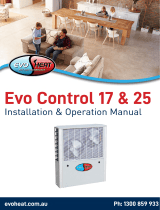 evoheat Control 17 & 25 Series Owner's manual
evoheat Control 17 & 25 Series Owner's manual
-
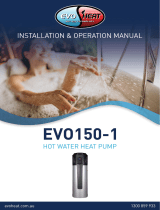 evoheat EVO150-1 User manual
evoheat EVO150-1 User manual
-
evoheat DHP30-R Owner's manual
-
evoheat DHP30-R Owner's manual
-
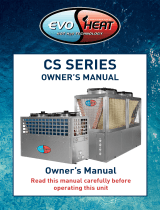 evoheat CS Owner's manual
evoheat CS Owner's manual
-
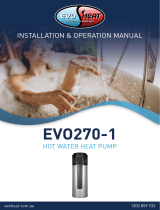 evoheat Evo270-1 User manual
evoheat Evo270-1 User manual
-
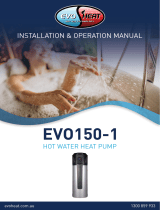 evoheat EVO0150-1 Hot Water Heat Pump User manual
evoheat EVO0150-1 Hot Water Heat Pump User manual
-
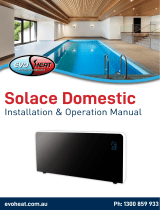 evoheat Solace Domestic Owner's manual
evoheat Solace Domestic Owner's manual
-
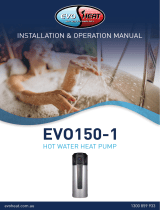 evoheat Evo 150-1 User manual
evoheat Evo 150-1 User manual
-
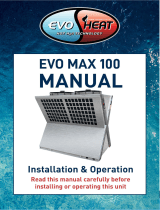 evoheat Max 100 Owner's manual
evoheat Max 100 Owner's manual
Other documents
-
Evo Edge-i ManualNEW Owner's manual
-
EVO HEAT Edge-i Series User manual
-
Evo CS-i Manual Commercial Inverter Heat Pump Owner's manual
-
Evo ULTRA Owner's manual
-
Evo ULTRA Owner's manual
-
Evo 150-1 Manual Owner's manual
-
Evo Force i-Manual Inverter Heat Pump Owner's manual
-
EVO HEAT EVO Fusion-i User guide
-
Evo Advanced DHP-R Manual Owner's manual
-
Evo Max Series Manual Commercial Hot Water Owner's manual






























